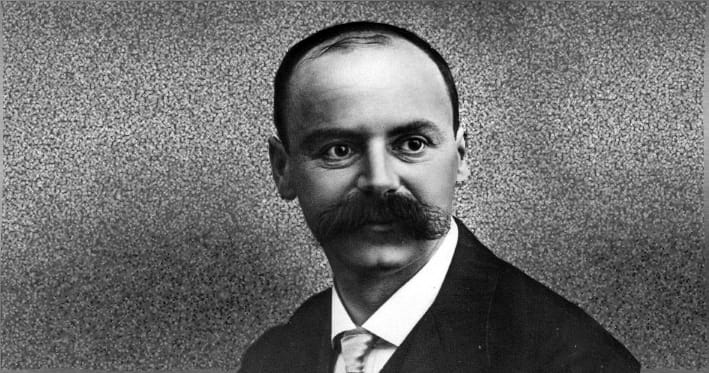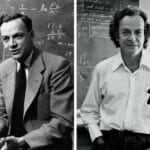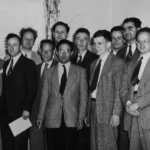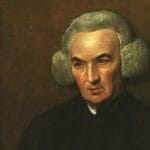Get ready for a mind-blowing trip into the life of Karl Schwarzschild, a genius astrophysicist who rocked our understanding of the universe. From fighting in the trenches of World War I to making discoveries that helped us grasp black holes, Schwarzschild’s story is a wild ride. We’ll delve into the unbelievable journey of this scientific superstar, uncovering the incredible facts that made him a legend in the world of physics and astronomy.
Unbelievable Facts About Karl Schwarzschild
Karl Schwarzschild – the name might not ring a bell for many, but this guy was a rockstar in the world of physics. He was like the Sherlock Holmes of space, solving cosmic mysteries that left others scratching their heads. What’s even more amazing is that he did all of this while battling a serious illness and serving in the trenches during World War I. Talk about dedication!
Let’s dive into some mind-blowing facts about this extraordinary scientist:
1. The Black Hole Whisperer: You know those cosmic monsters called black holes that gobble up everything in their path, even light? Well, Schwarzschild was the first to really figure them out. He took Einstein’s theory of relativity (which is already pretty mind-bending) and used it to prove that black holes weren’t just some sci-fi fantasy – they were real! Not only that, he even figured out how to calculate their size, which we now call the Schwarzschild radius.
2. Wartime Wonder: Imagine being stuck in a war zone, dealing with the stress of battle, and still finding the time and energy to revolutionize our understanding of the universe. That was Schwarzschild! While serving as an artillery officer during World War I, he was also busy scribbling down equations that would change how we view the cosmos. Sadly, he was struck by a rare skin disease during the war and died shortly after, but his groundbreaking work continued to inspire generations of scientists.
3. More Than Just Black Holes: While Schwarzschild’s work on black holes is legendary, this scientific superhero had his fingers in many cosmic pies. He made significant contributions to our understanding of how stars evolve over time and the mysterious nature of celestial dust. His research laid the foundation for countless discoveries in these fields, making him a true pioneer of astrophysics.
4. A Jack of All Trades (and a Master of Science!): Schwarzschild wasn’t just a one-trick pony. He was a true Renaissance man of science, fascinated by everything from the way light bends (optics) to the language of the universe itself (mathematics). He was also an expert in mapping the stars (spherical astronomy) and even dabbled in the art of photography. This incredible versatility allowed him to see connections others missed, unlocking secrets hidden within the fabric of the universe.
5. A Legacy that Reaches for the Stars: It’s no surprise that scientists wanted to honor this extraordinary man. Today, the powerful Schwarzschild Telescope, named in his honor, continues to scan the cosmos, making groundbreaking discoveries that build upon Schwarzschild’s legacy. His work continues to inspire and guide us as we explore the vast and mysterious universe he dedicated his life to understanding.
Did Karl Schwarzschild Fight in WW1?
Yes, it’s true! Karl Schwarzschild, the brilliant mind behind groundbreaking discoveries in astrophysics, also served in World War I.
In 1914, at the age of 40, Schwarzschild enlisted in the German army. He served on both the eastern and western fronts, putting his sharp mind to work on ballistic calculations for the artillery. He even rose to the rank of second lieutenant. Imagine making groundbreaking discoveries about the universe while simultaneously navigating the trenches of a global conflict.
Tragically, Schwarzschild developed pemphigus, a painful autoimmune disease, during his time in service. Despite the war and his declining health, he produced his most groundbreaking work during this time, developing the first exact solution to Einstein’s field equations of general relativity. This monumental achievement laid the groundwork for our understanding of black holes.
Schwarzschild’s life was cut short by pemphigus in 1916 at the age of 42. His death was a tremendous loss to the scientific community, but his legacy, including the concept of the Schwarzschild radius, continues to inspire physicists and astronomers today.
What Did Karl Schwarzschild Discover?
Karl Schwarzschild was a scientific trailblazer who made groundbreaking discoveries in multiple fields. He was the first to solve Einstein’s equations of general relativity, and his solution described a black hole and its Schwarzschild radius – the point of no return around a supermassive object where gravity is so strong that nothing, not even light, can escape.
Beyond black holes, Schwarzschild was a pioneer in quantum theory, working to understand the behavior of particles at the smallest level. He made strides in understanding how stars work, developing ways to measure their brightness, speed, and the balance of energy within them.
Schwarzschild’s contributions to our understanding of black holes, quantum mechanics, and the workings of stars solidify his place as a genius who revolutionized our understanding of the universe.
Did Schwarzschild Predict Black Holes?
While he may not have used the term “black hole,” Karl Schwarzschild’s work essentially predicted their existence. Just a year after Einstein published his theory of general relativity in 1915, Schwarzschild found a way to solve Einstein’s equations for the area around a single, massive object, a solution known as the Schwarzschild radius.
This radius describes an invisible boundary around supermassive objects. Anything crossing this boundary, even light, is trapped by the object’s immense gravity – a black hole! While Einstein initially found the idea of black holes far-fetched, Schwarzschild’s work provided a mathematical framework to understand these cosmic entities.
Schwarzschild’s solution focused on static, non-rotating black holes. Today, we know that black holes are dynamic and spinning, making his solution a simplified view. However, his contributions were essential in laying the groundwork for understanding these gravitational giants and continue to inspire research into the mysteries of black holes.
What is True About the Schwarzschild Radius of a Black Hole?
The Schwarzschild radius, also known as the event horizon, is an invisible sphere surrounding a black hole. Anything crossing this boundary – be it light, spaceships, or anything else – is trapped forever by the black hole’s immense gravitational pull.
The Schwarzschild radius is directly proportional to the mass of the black hole. Larger black holes have larger Schwarzschild radii. Additionally, rotating black holes, or those that spin, have slightly different radii than their non-rotating counterparts due to angular momentum. What happens inside this radius remains a mystery, but it is a realm where space and time are theorized to be warped and twisted, even potentially torn apart.
What are Some Fun Facts About Karl Schwarzschild?
Beyond his groundbreaking work in physics, Karl Schwarzschild was a man of many talents. He was a child prodigy, accepted into a prestigious university at 16 and earning his doctorate by 22.
Music was another passion, and he was accomplished in playing both the piano and cello, even composing his own pieces.
Schwarzschild was also a war hero, serving in the German army during World War I and receiving the Iron Cross for his bravery.
Tragically, his life was cut short at 42 by pemphigus, a rare skin disease. Even while battling this illness, he continued his scientific work. Schwarzschild’s life, though brief, serves as a testament to the diverse forms brilliance can take.
Who Was the Physicist Killed in WW1?
Karl Schwarzschild, a brilliant physicist who made significant contributions to electromagnetism, celestial mechanics, and general relativity, tragically lost his life in World War I.
Before the war, Schwarzschild was already making waves in the scientific community. In 1915, he accomplished the incredible feat of solving some of Einstein’s complex equations of general relativity. This solution, known as the Schwarzschild metric, provided a way to understand the space surrounding massive objects like black holes.
Despite his scientific prowess, Schwarzschild felt a duty to his country and enlisted in the German army during World War I. He served on both the Eastern and Western Fronts, even continuing his scientific work between battles.
Tragically, Schwarzschild contracted pemphigus, a rare skin disease, while stationed in Russia in 1916. He died later that year at just 42 years old. His untimely death was a significant loss, as his groundbreaking work on black holes and general relativity continues to shape our understanding of the universe today.
Was There Any Fighting on German Soil in WW1?
While Germany was heavily involved in World War I, fighting on both the Eastern and Western Fronts, their homeland remained remarkably untouched for most of the war. This was due in part to their war strategy, which focused on securing a swift victory in the west before turning their attention to the east.
However, there was one notable exception. At the very beginning of the war in 1914, Russia launched an offensive into East Prussia, a region that is part of present-day Germany. The Germans were initially caught off guard but managed to regroup and repel the Russian forces.
Despite the lack of fighting on German soil, the country was not exempt from hardship. The British Royal Navy imposed a blockade on German ports, leading to food shortages, especially during the “Turnip Winter” of 1916-17. While cities and landscapes in other countries were ravaged by trench warfare, German cities remained largely intact.
Who Was Most at Fault for WW1?
Pinpointing a single culprit for the outbreak of World War I is a complex task that continues to spark debate among historians. While Germany’s expansionist ambitions and military buildup played a significant role, other factors and key players contributed to the escalation of tensions.
Some historians argue that Austria-Hungary’s harsh ultimatum to Serbia following the assassination of Archduke Franz Ferdinand was a pivotal moment. They contend that Austria-Hungary’s actions, fueled by a desire to punish Serbia, were a major catalyst for the conflict.
Others point to Russia’s mobilization of troops in defense of Serbia, which was perceived as a threat by Germany. Additionally, some believe that Britain and France could have done more to prevent the war by taking a stronger stance against Germany’s early aggression or by reining in their allies.
The outbreak of World War I was a culmination of several factors, including nationalism, militarism, and a complex web of treaties. Diplomatic failures and the inability to find peaceful solutions ultimately led to one of the deadliest conflicts in human history.
Who Didn’t Have to Fight in WW1?
While World War I was a global conflict, not everyone was sent to the front lines. Certain groups were exempt from military service, including those in Scheduled Occupations, Conscientious Objectors, and those with medical exemptions.
Scheduled Occupations were deemed essential to the war effort at home. These included clergymen, teachers, coal miners, doctors, and iron and steel industry workers. The government recognized their value in maintaining societal functions and supporting the war effort indirectly.
Conscientious Objectors, or COs, refused to fight due to religious, moral, or political beliefs. In Britain, around 16,000 men became COs, facing varying levels of understanding and punishment. Their stance was a testament to their convictions during a time of intense pressure to conform.
Individuals with medical exemptions were excused from service due to physical or mental health conditions that made them unfit for combat. These exemptions ensured that individuals with severe asthma, epilepsy, debilitating injuries, or other conditions were not placed in harm’s way.
Did Any Swedes Fight in WW1?
Sweden remained officially neutral during World War I to protect its trade interests and avoid entanglement in the conflict. However, despite their neutrality, some Swedes did participate in the fighting.
The Finnish Civil War, which occurred concurrently with World War I, drew the attention and sympathy of many Swedes. A significant number of Swedish volunteers formed the Swedish Brigade and fought alongside Finnish forces.
The Swedish Brigade played a pivotal role in the Battle of Tampere, a turning point in the Finnish Civil War. Their involvement highlights the complexities of neutrality during wartime and demonstrates that individual actions do not always align with official national stances.
While Sweden’s neutrality shielded it from direct involvement in World War I, it did not completely insulate the country from the war’s effects. Trade restrictions and food shortages impacted Swedish society, and the experience shaped the nation’s post-war policies and approach to international relations.
For those seeking a deeper understanding of Karl Schwarzschild’s life and work, you might find these articles intriguing:
Looking for mind blowing facts about Askia Muhammad I? This is the ultimate resource! Interested in some fascinating facts about Epictetus? Then you’re in the right place.













2 thoughts on “Unbelievable Facts About Karl Schwarzschild: The Untold Story of a Genius”
Comments are closed.